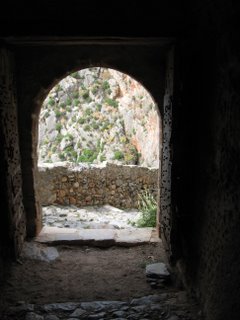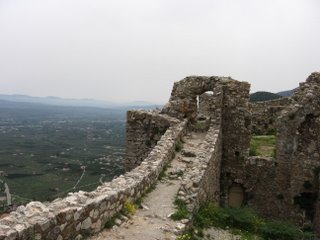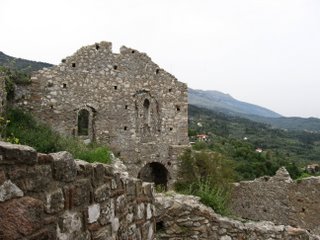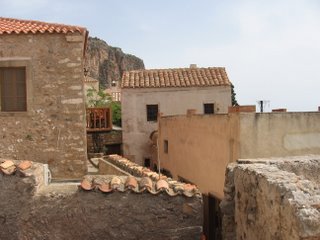
Where was I? Where am I? I've been in so many places lately that the past two weeks feel more like four. I'll get to it all eventually, I suppose, but for now I'll start where I left off; as I departed from Nafplio on Sunday afternoon two and a half weeks ago.
I was headed to Sparti, formerly known as Sparta, the ancient rival of Athens. Unfortunately, there are no direct Nafplio-Sparti buses, so I found myself transferring in the town of Tripoli. Just to make things confusing, Tripoli has two bus stations. There's the new, fancy local bus station, where buses from all over the prefecture of Argolis arrive and depart, and the tiny, hidden, secret bus station, where buses from all over Greece arrive and depart, mostly on their way from Athens to Sparti. I arrived at the first and found the second with the help of a very nice local man, who kept giving me directions in Greek, watching me walk off in the wrong direction, and giving me more directions in Greek. You may attribute this misunderstanding to the fact that I was receiving instructions in a foreign language, but I know better. I simply have no sense of direction. I am one of those people that has to take several moments to think about right and left every single time they come up in conversation.
Anyway, I successfully changed buses in Tripoli, somehow, though the bus to Sparti was so packed with people that I ended up standing for a while, then squished next to a guy who was sitting on another guy's lap. It was definitely a very safe way to travel.
I arrived in Sparti, found a hotel, and headed out to find some dinner. It was already after 10pm, and I was tired, so I stumbled into the first place I could find, a souvlaki place on the main street. There were no tables available inside, so I asked the waiter, in stumbling Greek, if I could sit outside.
"Of course you can!" he replied, in perfect English. "I mean, it's too cold to sit outside, but if you want to sit outside, you're more than welcome." He then proceeded to accompany me to the table, explain the menu, give me the history and economic background of Sparti and his own life story, and ask me what I wanted to eat. "You don't have to have anything of course, " he explained. "You can just sit here if you want, we don't care. But if you want to order something, let me know."
Turns out he's Canadian-Greek, born in Canada and moved back here when he was twelve. That explained both the perfect English and the hint of a northern accent that reminded me of some of my Minnesotan friends at Grinnell. It was a bit of cognitive dissonance, hearing a Greek speak with a Canadian accent. It probably shouldn't be, though. Sparti seemed to be filled with former ex-pats; the next day I had coffee at a place owned by a former Greek New Yorker.
I collpased into bed soon afterwards, and awoke fairly early the next day. I caught the 10am bus to Mystras, 6 km out of town.
You've probably never heard of Mystras, because it's not nearly as famous as some of the more ancient ruins of Greece. However, it is spectacular. It's not just a palace but an entire Byzantine city, built right into a hillside overlooking Sparti. Actually, it's more of a mountain than a hillside, as I found out when I started climbing. Lonely Planet, (which I trust implicitly ever since I read their New York book and discovered they recommended most of my favorite restuarants,) says you should start at the top of the city and work your way down. Unfortunately, this is not an option for us carless budget travellers, and not only did I end up starting at the bottom, I actually had to hike up fifteen minutes worth of hill before I even reached the entrance.
Before I embarked on this trip, I believe I spent a few days thinking about how nice it would be to relax for a while; I'd been running around the track at school for a number of consecutive days, and my legs were starting to get a bit sore. Little did I realize that all of the interesting sites would be way the hell up on cliffs.
Enough about my pathetic calf muscles. The fact of the matter is, Mystras was worth every sore limb. If only every jog I took were rewarded with such spectacular sights. Mystras was built like most cities of its kind, in different levels. At the top is the kastro, or the castle, the most heavily protected structure in the whole city.
 Here's the view from the top, which was pretty spectacular, especially since I could look down and think "Oh my god, I CLIMBED THAT." Below the kastro were several other levels, filled with monastaries and various homes. Basically, it was a hierarchy of the most literal sort; the higher up you were, the richer you were, and the better protected you were.
Here's the view from the top, which was pretty spectacular, especially since I could look down and think "Oh my god, I CLIMBED THAT." Below the kastro were several other levels, filled with monastaries and various homes. Basically, it was a hierarchy of the most literal sort; the higher up you were, the richer you were, and the better protected you were.Here are some pictures of Mystras. I might as well tell you that they don't do it justice.




The monasteries of Mystras were plentiful and the frescoes are still visible on many of the chapel walls.
 Here's an abandoned church; you can just make out some figures on the walls, now crumbling.
Here's an abandoned church; you can just make out some figures on the walls, now crumbling.The amazing thing about Mystras was that it wasn't just one castle or one ancient building, it was a whole maze of ruins of homes, chapels, buildings, and who even knows what else? You could poke around in there for hours and not even know what you were looking at. I got so involved in poking around in various places that I stumbled across a living man, possibly some sort of restoration worker, sipping his iced coffee frappe in one of the tiny turrets off of a chapel. Surprised, I stumbled back and mumbled, "Signomi!" (Excuse me!) He shurgged, laughed and said "My office! You see, I have coffee, nice view, everything I need."
I also managed to stumble across a large number of Germans, most of whom I mistook for Americans before I overheard them speaking. It seems that one does not have to be American to wear clothes with names of American places on them. I knew that already, of course. Here in Thessaloniki I know a girl that frequently wears a sweatshirt with the words "Bedford-Stuyvesant; Harlem" emblazoned across the front. I have to restrain myself from cracking up every time I see it. (For those of you not from New York, Bedford-Stuy and Harlem are almost as far away from one another as it is possible for two Manhattan neighborhoods to be.)
After I started my descent from Mystras I also stumbled across an actual working monastery, which appeared to have a number of actual nuns inside, as well as some cats. I was impressed.
After Mystras I took the bus back to Sparta and collapsed. It was a figurative sort of collapse, as it allow for ice cream consumption and blog updating, but it did not allow for much more sightseeing. I was exhausted.
It was nearing 8pm when I headed down to the bus station and purchased my ticket to Monemvasia. I had heard about Monemvasia from an eighth grader, and thought it sounded pretty interesting, though I couldn't quite picture it; some sort of big rock in the water? I didn't really get what it was, exactly. But I hopped on the bus to find out, and the ticket seller informed me that it was the "most beautiful city in the whole world," so I thought it sounded pretty good.
We arrived in a town called Gefyra at 10:30pm, in the dark, and I was dead tired. My book said that Gefyra was actually connected to Monemvasia in some way that I didn't fully understand, so I got off the bus and walked a bit. It smelled like the ocean. It looked cute in a touristy sort of way. I was reminded of Bar Harbor Maine, which smells very similar in a sort of salty nautical way.
I walked down the main street of this little town, glancing about in search of a hotel, when I noticed something just barely visible in the darkness; a giant rock.
 Here's what it looked like the following morning. At night it was a bit spookier and even more mysterious in appearance. And it's huge. I stood there and stared at this strange formation for a while, noting that there were several lights glowing right by the other end of the bridge. It was rather fascinating.
Here's what it looked like the following morning. At night it was a bit spookier and even more mysterious in appearance. And it's huge. I stood there and stared at this strange formation for a while, noting that there were several lights glowing right by the other end of the bridge. It was rather fascinating.The town of Monemvasia, you see, used to be part of the mainland, until an earthquake separated it. To get there nowadays, you walk across the bride pictured, and around the massive rock until you reach a little tunnel. You walk through the tunnel and suddenly you find yourself in a different century. Well, almost. A different century with a few souvenir shops and hotels added in. But a charming different century nonetheless.


They even carry supplies by mule here; I followed several of them around the bend. You can see one in the picture on the right, heading towards the town wall on his way out.
Monemvasia is a fascinating mix of things; you can walk amongst the Byzantine ruins of an ancient church, then walk five feet down the street and have coffee at a very modern little cafe. Unlike Mystras, Monemvasia is a living town, not a ghost world, a fact that makes it both charming and less mysterious. It's a bit harder to sense to centuries of time that it has endured, but you get a feel for what it would be like to live in a medieval city. After all, the Byzantines didn't sit around and wax poetic when their walls crumbled, they rebuilt them. In the museum, they even show you how the Byzantines reused bits of decorative marble. So perhaps rebuilding the place is not a modern corruption, but just the natural way of things. God knows, if nobody ever built over ancient stuff, all of Greece would have to close down and become a giant branch of a museum.
Farther up the rock, though, things are less commercial and more ghostly. I had not bargained for another hike, but once I realized that there were sights to see at the top, I wasn't going to pass up the chance to see them. Yet again, I climbed my way to the top of an ancient city, where I was rewarded with the church of St. Sophia and a number of other crumbling relics, plus a gorgeous view.

 I spent all morning wandering through the various incarnations of Monemvasia, examining the artifacts in the museum, examining the postcards in the shops, and examining the ruins among the homes and inns.
I spent all morning wandering through the various incarnations of Monemvasia, examining the artifacts in the museum, examining the postcards in the shops, and examining the ruins among the homes and inns.It was past noon when I headed back over the water to Gefyra, and forward several centuries. There I found Greece in its more modern incarnation. The following picture was taken there.
 It's for Joe, who assures me that he is going to read this at some point. (Yup, these are real. I wasn't sure, at first.)
It's for Joe, who assures me that he is going to read this at some point. (Yup, these are real. I wasn't sure, at first.)At 2:15 I caught the bus back north, heading for another, more familiar ancient city. But that story I will leave for another day.


4 comments:
Hey Emmie! This all sounds so wonderful and the pictures are beautiful. I think that the Greek Tourist Board should put you on the payroll! I think you have been away from home for too long--Be Stuy is not is Manhattan! Maybe your Brooklyn roots need refreshing? Love Ya!
Did I say Manhattan? Whoops. Maybe I was getting it confused with Stuyvesant town. I did say that I have no sense of direction.
I am totally enthusiastic about being put on any payroll that anyone cares to put me on.
This are great travelogues. I haven't had much occasion to see much of Greece aside from the four places we've lived (Athens, Kos, Litochoro, and now Thessaloniki).
I am one of those people that has to take several moments to think about right and left every single time they come up in conversation.
THANK YOU for that. I am exactly the same way. Noone believes anyone else has the same issue, so now I can point them to your blog!
I didn't like the profanity in that T-shirt about NYC.
What would Jesus say?
Post a Comment